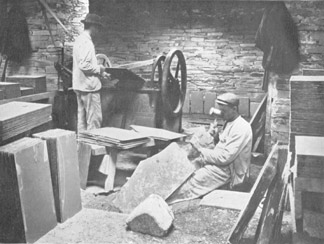Quarrying Techniques - Working the
Slate
 (It is very important to bear in mind that
since the quarrying was a Welsh language industry, the
translations into English are only meant to give an idea of the
meaning of the original. These English versions are modern
literal translations. It is important to know that the
terminology did vary to some extent from area to area. The terms
used here are in the main from the Llanberis area.) (It is very important to bear in mind that
since the quarrying was a Welsh language industry, the
translations into English are only meant to give an idea of the
meaning of the original. These English versions are modern
literal translations. It is important to know that the
terminology did vary to some extent from area to area. The terms
used here are in the main from the Llanberis area.)
The bargen is assessed before seeing to the llnau
(cleaning up) as well as ascertaining that there is no
dangerous crib yn hongian (overhang) remaining. Then it
was time to dragio, (lit dragging), that is to use a
cyn manhollt (lit. small splitting chisel) and the
morthwyl dragio (a three pound hammer) to brashollti’r
plygion (rough slit the slate blocks) with the grain, into
pileri (pillars) between 30 and 60 cms wide. These would
then be lifted on to the sledge, but using a crane today of
course to be transported to the wal (shed.) This, before
the siediau hollti, (chipping sheds) were built during the
second half of the twentieth century, was an area around 90cm
to105cm where the holltwr (splitter) and naddwr
(chipper) would work. There is a circular saw, (diamond by
today) in the shed to saw the clytiau (small blocks) into
crawiau tenau (thin slabs) ready to be split. Once split,
the slate then becomes y garreg, (lit. the stone.)
Hollti (splitting) needs a very special expertise. The
holltwr sits on a block of wood known as the blocyn
hollti (splitting block) or blocyn tin (bum block), legs
folded, with the clwt resting on his left knee. His tools are two
or three-cyn manollt or a cyn tew wyth (lit. a chisel
fat eight, [fat eight meaning a block of slate wide enough to be
split into eight slates,]) together with a gordd y wal (a
wooden mallet of African oak.) The thickness of the best
stones are six stones to 2cm. The crawiau are then placed
on a flat stone, the garreg bentwr (pile slab) ready to be
chipped. The jermon is usually responsible for this.
Then the naddwr places the crawen dena or
sglodyn (chips) on the blade of the drafael (a
bench with a fixed iron blade, used in conjunction with the
cyllell naddu [lit. chipping knife] for hand trimming roof
slate.) A machine is used for this process by now. Two sides are
cut straight first to achieve a straight edge. It is then
measured using the pren mesur lit. a measuring stick.)
This is a piece of wood, a nail at one end with graduated inch
steps till fourteen inches is reached, the changing to two inch
steps until twenty four inches is reached. After marking the
slate, two remaining sides are then chipped resulting in a
perfect rectangular slate of the proper dimensions. Before the
days of the engine, an experienced chipper could reach a target
of between five hundred and six hundred finished roof slates a
day.
Electrically driven machines are now used. Granted finished
slates are produced much quicker, but more waste is produced
especially if the slates are exceptionally thick or hard.
Llanberis quarrying terms were used here, but it must also be
remembered that there were variations of names used in different
localities.
In Blaenau Ffestiniog a vein of slate was known as a llygad
- llygadau (eye-eyes). It was a name given since the
quarrymen would open the rock, thus opening the slate's
'eye.'
Llygadau Names of Blaenau
Ffestiniog
Llygad Mochyn
Llygad Cefn/Llygad Coch (back/red)
Llygad Bach (little)
Hen Lygad
Llygad Newydd
Llygad y Moelwyn
Llygad Thomas Edwards
Llygad Glan y Pwll
Llygad Llwyd |
North Vein
Back Vein
Narrow vein
Old Vein
Lygad y Graig Ddu (black rock eye)
Moewlyn Vein
Second Moelwyn Vein
Olive Vein
Grey Vein
|
Gwythien (Vein) is a thin layer of rock, many of which
are found in a gwely (bed). The width of the Hen
Lygad in one of the Ffestiniog Quarries is 70 yards and
contains 27 veins.
Widths and Veins of the Hen Lygad
Ithfaen glas (slont glai)
Gwythien y Meinars
Y Wythien Isaf a'r Tri Teulu
Gwythien Crych Du Bach
Gwythien Crych Du Mawr
Y Wythien Sylffar
Y Pum Wythien
Y Wythien rhwng y Pump a'r Wythien Wen
Y Wythien Wen a'r Teulu
Yr Ail oddi-wrth y Wythien fawr
Y Wythien Fawr
Y Wythien Ddu
Y Wythien Gam
Yr Ail Wythien Gam
Y Gwythiennau Mân..y gorn a'r frith
Pen Uchaf y Llygad Caled (tew bras)
Y Wythien Galed a'r Teulu
Yr Ail Wythien Galed
Y Wythien Lwyd
Y Wythied Fflat
Y Wythien Grych
Sylffar y Llygad Caled Isaf
Y Wythien Galed Isaf
Gwythien y Smotiau Isaf
Gwythien y Sylffar Du a'r rhai diweddaf |
blue granite
miners' vein
lower vein and three family
small black crooked vein
great black crooked vein
the sulphur vein
the five vein
the vein between the five and the
white vein
the white vein and family
the second from the great vein
the great vein
the black vein
the crooked vein
the second crooked vein
the small veins..the horned and
speckled
top head of the hard eye
the hard vein and family
the second hard vein
the grey vein
the flat vein
the crooked vein
the sulphurous hard lower eye
the lowest hard vein
the lower spotted vein
the black sulpgur vein and the
latest ones |
This is the traditional way Slates
were Counted:
Bwrw/mwrw
Cant bach
Cant mawr
Dau gant bach |
3 carreg (slates)
10 mwrw and 2 garreg (32 slates)
4 cant bach (128 slates)
1 pwn ceffyl (horse pack) |
Slate sizes
It is believed that it was Colonel Hugh Wilburton of
Winnington, Cheshire, and co owner of the Penrhyn estate who
invented the names of some at least of the various slate sizes.
As Chancellor and Chamberlain of Anglesey, Caernarfon shire and
Meirionydd he was very influential figure. Indeed he was
appointed as first Provincial Grand Master of the Masonic
Province of North Wales, holding the post until 1741, when
William Vaughan of Corsygedol was appointed in his stead, who was
one of the founder members of the London Cymmrodorion Society and
a great friend of the Morris brothers. His only child and
heiress, Ann, married Richard Pennant, the first
Lord Penrhyn of the first creation in 1765. Their marble
memorial can be seen in the parish church of Llandygai.These are
the names and sizes of the various roof slates in inches.
|
 (It is very important to bear in mind that
since the quarrying was a Welsh language industry, the
translations into English are only meant to give an idea of the
meaning of the original. These English versions are modern
literal translations. It is important to know that the
terminology did vary to some extent from area to area. The terms
used here are in the main from the Llanberis area.)
(It is very important to bear in mind that
since the quarrying was a Welsh language industry, the
translations into English are only meant to give an idea of the
meaning of the original. These English versions are modern
literal translations. It is important to know that the
terminology did vary to some extent from area to area. The terms
used here are in the main from the Llanberis area.)


